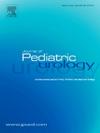Mirabegron as part of combination therapy for treatment refractory neurogenic bladder in pediatric patients with spina bifida
IF 1.9
3区 医学
Q2 PEDIATRICS
引用次数: 0
Abstract
Introduction
Medical therapy for patients with neurogenic bladder secondary to spina bifida is a key element in their management. Mirabegron has been shown to improve abnormal bladder wall dynamics in the neurogenic bladder (NGB) population, but there is limited information on its efficacy as additive therapy in the treatment of refractory NGB in pediatric literature.
Objective
This study assessed the utility of mirabegron as combination therapy in pediatric patients with spina bifida who have insufficient improvement of bladder dynamics on antimuscarinic monotherapy. We hypothesized that using mirabegron in combination with antimuscarinic therapy would lead to improved bladder dynamics on repeat urodynamic studies.
Study design
This was a retrospective review of pediatric patients treated at 2 centers were included if there were high-risk urodynamic findings and/or persistent incontinence on a single antimuscarinic agent. Pre and post dual therapy initiation urodynamic assessment was performed.
Results
We included 103 patients at a median age of 10.7 years on a median of 166 days of treatment. Dual therapy lowered detrusor opening pressures and end filling pressures, in addition to improving detrusor overactivity in 32 % of patients, even in the patients with the highest risk bladders (Figure).
Discussion
Limitations of the study include the retrospective design, the subjectivity of the treating physician in initiating Mirabegron, and the variability in urodynamic assessment. Our findings are consistent with the benefits of dual therapy in adult patients, extending this treatment option to the pediatric population.
Conclusion
The addition of mirabegron resulted in improvement in storage pressures and subjective incontinence in pediatric spina bifida patients not adequately managed with a single antimuscarinic agent.
Mirabegron联合治疗小儿脊柱裂难治性神经源性膀胱。
简介:医学治疗继发于脊柱裂的神经源性膀胱是其治疗的关键因素。Mirabegron已被证明可以改善神经源性膀胱(NGB)人群的异常膀胱壁动力学,但在儿科文献中,关于其作为治疗难治性NGB的辅助疗法的疗效的信息有限。目的:本研究评估mirabegron作为联合治疗小儿脊柱裂患者的效用,这些患者在单药治疗中膀胱动力学改善不足。我们假设在重复尿动力学研究中,mirabegron联合抗毒蕈碱治疗可以改善膀胱动力学。研究设计:这是一项对在2个中心接受治疗的儿科患者的回顾性研究,如果有高风险尿动力学发现和/或使用单一抗毒蕈碱药物后出现持续性尿失禁。双重治疗开始前后进行尿动力学评估。结果:我们纳入103例患者,中位年龄为10.7岁,中位治疗时间为166天。双重治疗降低了逼尿肌开口压力和末端填充压力,除了改善32%的患者的逼尿肌过度活动外,甚至在膀胱风险最高的患者中也是如此(图)。讨论:该研究的局限性包括回顾性设计,治疗医生在启动米拉贝格龙时的主观性,以及尿动力学评估的可变性。我们的研究结果与成人患者双重治疗的益处一致,将这种治疗选择扩展到儿科人群。结论:在单药治疗不充分的儿童脊柱裂患者中,加入mirabegron可改善储存压力和主观尿失禁。
本文章由计算机程序翻译,如有差异,请以英文原文为准。
求助全文
约1分钟内获得全文
求助全文
来源期刊

Journal of Pediatric Urology
PEDIATRICS-UROLOGY & NEPHROLOGY
CiteScore
3.70
自引率
15.00%
发文量
330
审稿时长
4-8 weeks
期刊介绍:
The Journal of Pediatric Urology publishes submitted research and clinical articles relating to Pediatric Urology which have been accepted after adequate peer review.
It publishes regular articles that have been submitted after invitation, that cover the curriculum of Pediatric Urology, and enable trainee surgeons to attain theoretical competence of the sub-specialty.
It publishes regular reviews of pediatric urological articles appearing in other journals.
It publishes invited review articles by recognised experts on modern or controversial aspects of the sub-specialty.
It enables any affiliated society to advertise society events or information in the journal without charge and will publish abstracts of papers to be read at society meetings.
 求助内容:
求助内容: 应助结果提醒方式:
应助结果提醒方式:


